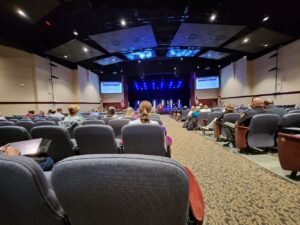Ohio’s School Safety Training Tackles Drug Education in Schools

By Taiwo AKINLAMI
The Ohio Department of Public Safety, through its School Safety Centre, hosted a two-part “Drug Education Training” on October 9 and 11, 2024, at Ohio Christian University and North Olmsted High School, respectively. The sessions brought together school administrators, educators, and community leaders from across Ohio to address the growing drug-related concerns affecting the state’s youth. The training aimed to equip attendees with knowledge and strategies to combat drug abuse and create safer environments within schools.

Understanding Youth Drug Trends: Fentanyl and the Rise of Synthetic Drugs
Alex Van Dyke, from the Ohio Narcotics Intelligence Center, opened the training by presenting on current drug trends, focusing on the rising threat of synthetic drugs, particularly fentanyl. Fentanyl, 50 to 100 times more potent than morphine, has dramatically altered the drug landscape in Ohio since its introduction into the illicit drug market in 2014. The low production cost and ease of trafficking have made fentanyl a popular choice for drug dealers, but it has had devastating effects on public health, contributing to the highest-ever recorded number of overdose deaths in Ohio, with 5,174 deaths in 2021.
Van Dyke also highlighted the emergence of counterfeit pills laced with fentanyl, a dangerous trend posing severe risks to young people. These counterfeit pills mimic legitimate prescription medications, making it nearly impossible for users to discern whether they are consuming safe prescription drugs or deadly imitations. The problem is exacerbated by traffickers targeting youth with colorful fentanyl pills, designed to appeal to a younger audience.
He warned that Ohio law enforcement had seized more than 115 million counterfeit pills containing fentanyl in 2023, an alarming statistic pointing to the scale of the crisis. He emphasized the importance of raising awareness and sharing public safety bulletins to educate students and parents about the dangers of these counterfeit pills.
The Growing Prevalence of Polydrug Mixtures
Van Dyke also delved into the rise of polydrug mixtures, which involve combining fentanyl with other substances like heroin, cocaine, or methamphetamine. These combinations significantly increase the risk of overdose, as the drugs amplify each other’s effects. Van Dyke stressed that polydrug mixtures are responsible for more than half of Ohio’s overdose deaths, highlighting the urgent need for schools to educate students on these dangers.
One of the most concerning aspects of Van Dyke’s presentation was the introduction of carfentanil into drug mixtures. Carfentanil, a synthetic opioid used to tranquilize large animals, is 100 times more potent than fentanyl. Its inclusion in drug combinations makes overdose reversal treatments, like naloxone, less effective, posing a significant challenge for public health and law enforcement.
Recognizing Signs of Drug Impairment: A Critical Skill for Educators
Another key session was led by Sergeant Samuel Criswell and Staff Lieutenant Nathan E. Dennis from the Ohio State Highway Patrol. Their presentation, titled “Signs of Impairment,” focused on helping educators recognize when a student may be under the influence of drugs. Dennis, with his extensive experience in drug recognition, walked participants through the seven categories of drugs used to evaluate impairment, ranging from CNS depressants and stimulants to narcotic analgesics and hallucinogens.
Dennis provided specific indicators for each drug category, helping educators better identify impaired students. For example, slurred speech and slow reflexes can indicate CNS depressant use, while hyperactivity and rapid movements often point to CNS stimulants. Recognizing these signs early is essential for intervention, as it allows educators to connect students with the support they need before the situation escalates.
Dennis also addressed the growing issue of polydrug use, explaining how the combination of substances—like alcohol and cannabis—can mask the effects of one drug, leading to overconsumption and increased overdose risk. The session reinforced the importance of vigilance among school personnel in identifying and addressing drug use within their student populations.

The Role of Social Media and Drug Slang in Drug Trafficking
In a session on “Social Media & Drug Slang,” Van Dyke returned to discuss how drug dealers have adapted to modern technology, using platforms like Instagram, Snapchat, and encrypted messaging apps to sell drugs to young people. Dealers often use coded language and emojis to evade detection by law enforcement. For instance, the cloud emoji (⛅️) may indicate high-quality marijuana, while snowflakes (❄️) reference cocaine.
Van Dyke urged educators to familiarize themselves with these digital signs and to educate parents and students about the risks of purchasing drugs online. The session underscored the complexity of addressing drug use in today’s digital age, where young people can easily access illicit substances through social media.
The Role of School Resource Officers in Combating Drug Use
A panel discussion featuring school resource officers (SROs) shed light on their role in combating drug use within schools. Officers like Deputy Shawn Clark and Officer Julie Reston highlighted the shifting trends in student drug use, particularly the increase in prescription drug misuse. They noted that students often have easy access to these drugs at home, further complicating prevention efforts.
Vaping, particularly with THC products, was identified as one of the fastest-growing forms of substance abuse among students. Officers discussed how schools are installing anti-vaping sensors in bathrooms, but students have become adept at avoiding detection, vaping in hallways or classrooms. The panelists called for more parental involvement in addressing these issues, noting that some parents are unaware of the potency of modern drugs like THC-laced vape pens.
The SROs also emphasized the importance of early intervention and educational programs, such as the DARE (Drug Abuse Resistance Education) program, which builds trust between officers and students, helping prevent drug use before it escalates.

The DREAM Program: A Comprehensive Approach to Drug Prevention
Amy Rogers, a contract educator for the Ohio Department of Public Safety, introduced the DREAM (Drug Resistance Education and Mentorship) program during the training. DREAM offers a K-12 video-based curriculum designed to teach students about substance abuse prevention, personal safety, and healthy coping strategies. Unlike punitive approaches, DREAM focuses on empowerment and education, aiming to reach students before they encounter drugs.
Rogers explained how the program provides age-appropriate resources, from basic medicine safety for young children to more complex issues like peer pressure and the impact of substance abuse on brain development for high school students. The program also includes resources for parents and educators, helping them navigate difficult conversations about drug use and risky behaviors.
Naloxone: A Lifesaving Tool in Combating the Opioid Crisis
The final session, led by Steven Dunn from the Ohio Department of Health, focused on naloxone, a life-saving medication that reverses opioid overdoses. Dunn provided a step-by-step guide on how to administer naloxone and recognize the signs of an opioid overdose, including unresponsiveness, slow breathing, and pinpoint pupils.
Dunn highlighted Ohio’s commitment to making naloxone widely available, with emergency naloxone cabinets installed in schools and public places. He also discussed the Good Samaritan Law, which protects individuals who administer naloxone from legal repercussions, encouraging attendees to carry naloxone as part of their emergency preparedness.
Conclusion
The “Drug Education Training” provided by the Ohio Department of Public Safety offered a comprehensive look at the drug-related challenges facing Ohio’s schools. Through expert presentations and practical tools, the event equipped educators and community leaders with the knowledge they need to address these issues and create safer, more supportive environments for students. As drug trends continue to evolve, Ohio’s schools are playing a crucial role in preventing substance abuse and protecting the state’s youth from the dangers of drug use.

Taiwo AKINLAMI is the Curator-in-Chief of the S.A.F.E for Children® Information Bank, Ohio, a project of Power Parenting Company LLC.





